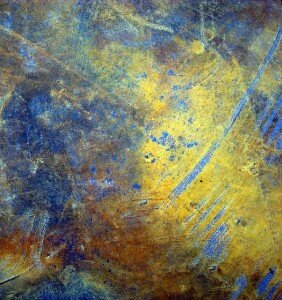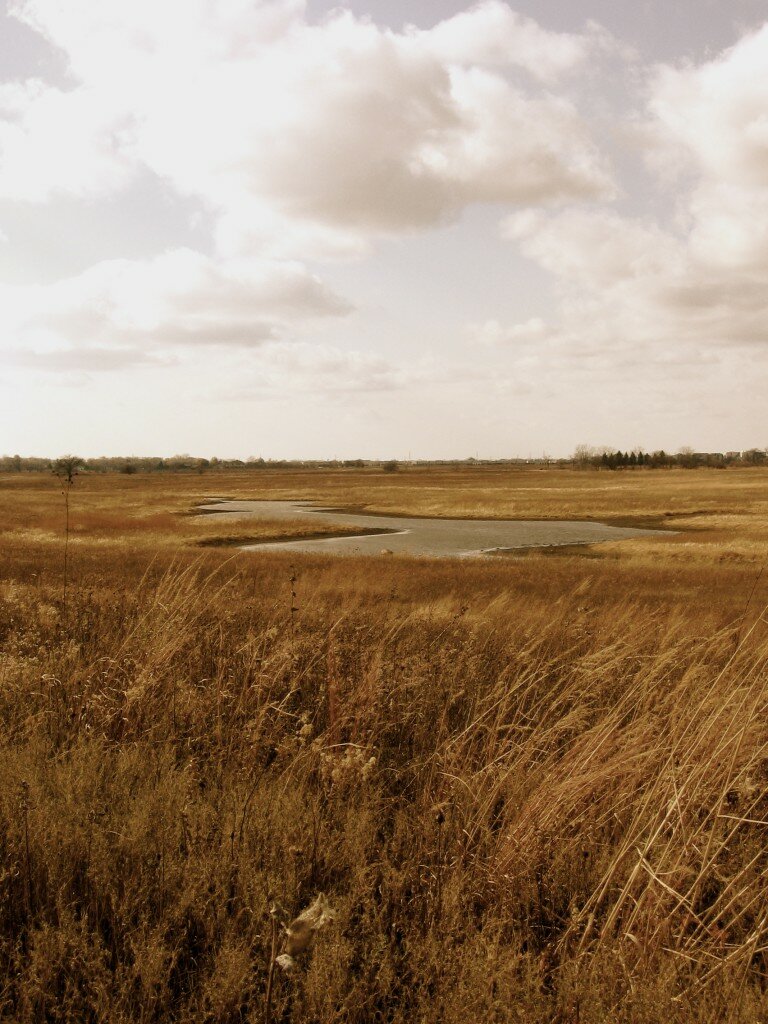by Cindy Crosby
[Ed. note: This article is part of our series of weekly reflections, called Deep Down Things, published on Wednesdays.]
To make a prairie it takes a clover and one bee,
One clover, and a bee,
And revery.
The revery alone will do
If bees are few.
- Emily Dickinson
Surely, it is your business, so far as you may, to express in action something of the real character of that universe within which you now know yourself to live?
- Evelyn Underhill, Practical Mysticism
As the autumn days grow shorter on the prairie, it’s the narrow slivers of time between light and darkness that are endlessly fascinating in their elusiveness. I deliberately linger on my walks, waiting for that moment when day passes the baton to night.
Across the two-track from the limestone ledge where I wait, the bunnies move noiselessly in the grassy hollow. They’re foraging for dinner under the gathering gloom’s cover. One…two…three…Soft brown ears barely show above the grasses as they sit back on their haunches, sniffing the air for predators. Above them the wind fingerpaints with the clouds, swirling in more purples, grays, and blacks. In the west, violet clouds are massing, loaded with liquid and advancing. Mars, shining red and warrior-like, plays tag with the full moon, which rides the waves of the darkening sky.
As the last light turns the midges rising off Willoway Brook into flying sequins, nighthawks and barn swallows mingle in the evening air, sieving it for insects. Indigo buntings murmur to each other from the cottonwood trees, and a great horned owl purrs in the woods that fringe the prairie. Prairie dropseed’s hot buttered popcorn smell infuses the air along the path as the first mosquito of the night pinches my bare arm. I lie full length on the limestone ledge, relishing the coolness of the rock against my cheek.
The sun is setting into the dark clouds, backlighting the landscape, and the temperature falls. Twilight begins.
That trick of the light. It is what drives me to paint, even though I do it poorly, but you can come closer to capturing the light through brushstrokes than you ever could do with a camera. The difficulty is, even when you get the light’s angle and the colors right with paints, the results look overdone. It’s a problem with autumn in general: all those contrasts of scarlet, lemon, and that odd burnished metal color of sky, with a black crow inking itself across it. It’s also a quandary with the fall landscape at dusk in particular, with angles of luminescence that change by the second. You can see why Monet kept painting the wheat stacks to explore the changes of the light.
The New England asters showcase the light-change effect, with their golden eyes fringed in deep purple glowing against the bleached-out backdrop of Indian grass right before sunset. The backlighting as the sun drops makes each blade, each petal, each leaf incandescent. On the prairie, the Indian-grass plumes brighten right as the sun falls below the earth’s horizon. The foamy seed heads catch the sun’s final rays, and the warm rose violet of the sky is reflected in the tawny warm colors of the tallgrass.
You can capture twilight to some extent with words, which is why I keep scribbling about it in my journal. I later read over the entries, and certain prairie scenes are vividly conjured up for me. Still, the words leave me vaguely dissatisfied.
Twilight also influences the creative arrangements in my garden. Tonight the white asters—aster simplex—are a thousand tiny stars; anything white is luminous in last light. I used to have a white garden for this reason, so I could sit outside at dusk and watch it glow in the evening right as the sun fell below the horizon. In my backyard, I still choose white flowers, shuffle them around to get the best effects, looking for the most brilliant blooms that will communicate beauty at dusk.
The Great Lakes Ojibwa Indians must have felt an artistic desire to communicate when they painted pictographs on the cliffs along Lake Superior’s shores. Some of their images were later covered with graffiti, and the disparity was notable. “There is a fundamental difference between aboriginal marks on stone and pioneer inscriptions, based on the separate philosophical relationships to the land. …One regarded land as a spiritual source of identity, the other saw land as property,” observes anthropologist Thor Conway in Painted Dreams. He also notes, “The soul speaks in the language of images and symbols.”
Our soul longs to speak. Isn’t this offering-up of our creativity a prayer in itself? Our soul speaking in paint, in words, in landscape? An attempt to open a window between us and something greater than ourselves that we dimly perceive, try to express?
Twilight is a mystery, a bit of the subconscious. Primitive. There’s a slight anxiety as the sun slips from sight. Will it return to bathe the world in light again?
The creative muse is also elusive. I often sit with my journal open, empty of words. I stare at the empty canvas, tentative,

Creating links us with the Creator. (cc image courtesy Hilarywho via flickr)
paralyzed. Flowers in my garden mysteriously die, pop up in unexpected places, or fail to appear in the spring, and I despair of ever making the garden in my head appear in my backyard. “In creating, the only hard thing is to begin: a grass blade’s no easier to make than an oak,” wrote James Russell Lowell. I find a thousand different reasons to put off beginning a creative project, especially when I know my best efforts will fall far short of what I envision.
But the urge to create remains.
This urge was understood by the mystic Evelyn Underhill, who knew the desire to pour out our creativity to God:
Artists, aware of a more vivid and more beautiful world than other men, are always driven by their love and enthusiasm to attempt the expression, the bringing into manifestation of those deeper significances of form, sound rhythm, which they have been able to apprehend: and in doing this, they taste deeper and deeper truths, make ever closer unions with the Real. For them, the duty of creation is tightly bound up with the gift of love. In their passionate outflowing to the universe which offers itself under one of its many aspects to their adoration, that other-worldly fruition of beauty is always followed, balanced, completed, by a this-world impulse to creation: a desire to fix within the time order, and share with other men, the vision by which they were possessed.
This fall crepuscular light is a marvel by itself; occasionally I see wonder upon wonder. One evening as I walk the two-track, a sun halo appears. It’s a rainbow-hued ring that fills the sky, with the bottom curve dropping out below the earth to the west. Two “sundogs”—little bright spots of rainbow-colored light on the halo’s sides—are clearly visible, riding the edges. Sun halos form when sunshine passes through ice crystals in cirrostratus clouds, and they often foretell rain or snow.
These are fairly common. Why haven’t I noticed them before? What else have I failed to pay attention to? The prairie sky gives me an almost panoramic view, a perspective difficult to have elsewhere in the Chicago suburbs.
Impossible to recreate. Extravagant. My artistic efforts to mirror the landscape around me always leave me vexed, yet determined to try again.
Darkness vacuums up the prairie’s shadows, and Willoway Brook turns black. Dawn has cycled to twilight. Having this desire to connect with my creator, I’ll pray with my brushstrokes, worship with my words, plant white asters in my garden.
And always, walk the prairie at sunset.
Cindy Crosby is the author of By Willoway Brook: Exploring the Landscape of Prayer, a contributor to the study guide, Creation Care, and co-editor of three volumes of the Ancient Christian Devotional series (Intervarsity Press).
Excerpted from By Willoway Brook: Exploring the Landscape of Prayer, Paraclete Press, 2003.

